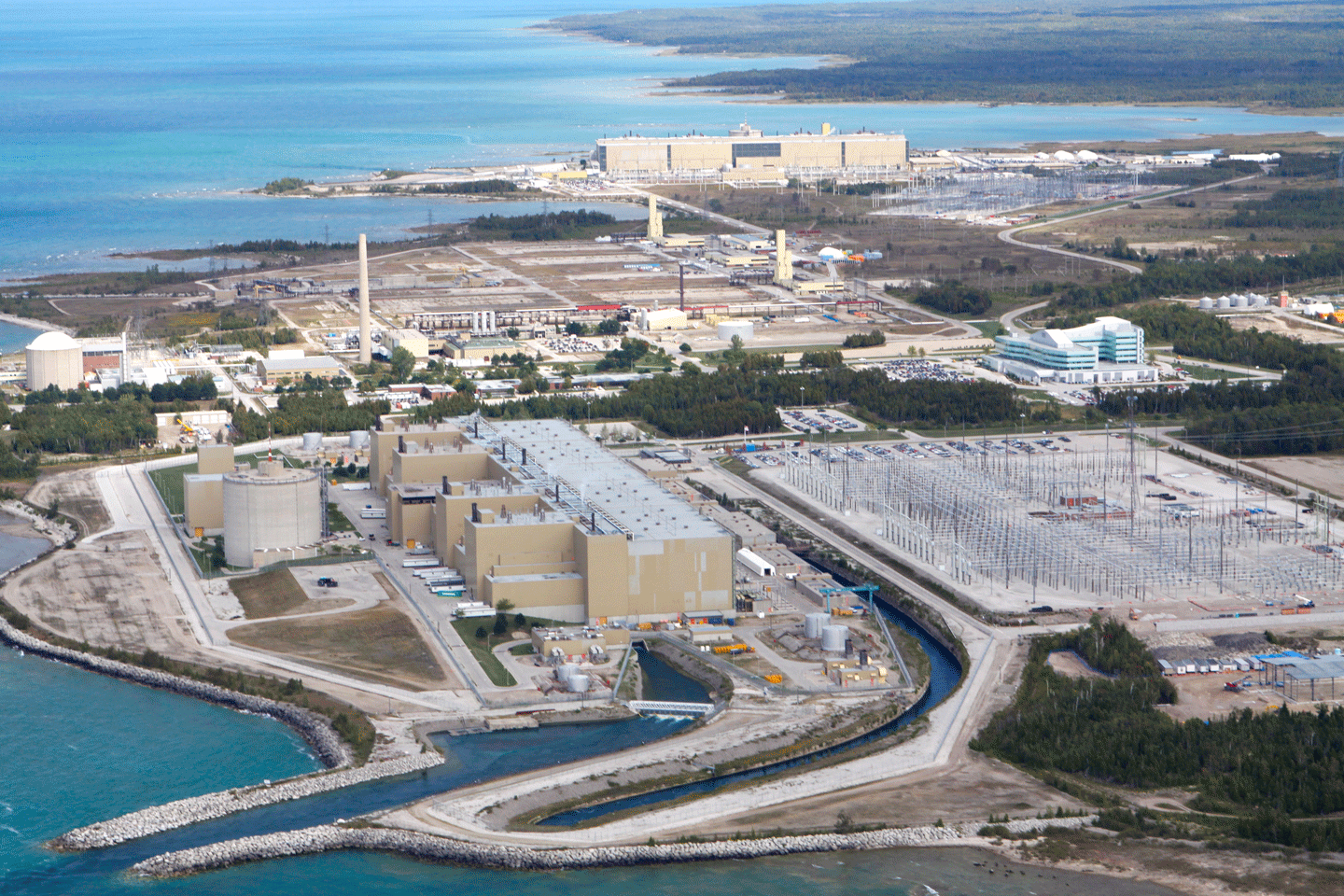Bruce A and B Nuclear Generating Stations
Bruce Power is licensed to operate the Bruce A and Bruce B Nuclear Generating Stations, located in the municipality of Kincardine on the eastern shore of Lake Huron, Ontario.
The CNSC has full-time staff at the stations who perform inspections to evaluate operations and to verify compliance with regulatory requirements and licence conditions.

Photo courtesy of Bruce Power
| Location: | Kincardine, Ontario |
|---|---|
| Licensee: | Bruce Power |
| Reactor type: | CANDU (CANada Deuterium Uranium) |
| Vendor: | Atomic Energy of Canada Limited |
| Number of units: | 8 |
| Installed capacity: | 6,232 MW (Bruce A & B combined) |
| Status: |
7 units: operating 1 units: Major Component Replacement (MCR) |
| Licence issued: | October 1, 2018 |
| Licence expires: | September 30, 2028 |
| Start of operation: | Between 1977-1979 for Bruce A and 1984-1987 for Bruce B |
| Licensing documentation: | Request a copy of the Bruce A and Bruce B licences and licence condition handbooks by email at cnsc.info.ccsn@cnsc-ccsn.gc.ca |
| Facility website: | Bruce Power |
Latest news
Commission proceedings
The Commission is an independent administrative tribunal set up at arm's length from government, without ties to the nuclear industry. Use the links below to find documents related to Commission meetings or hearings.
- September 9, 2023: Fourth regulatory hold point lifted for Bruce Nuclear Generating Station B Unit 6
- September 1, 2023: Third regulatory hold point lifted for Bruce Nuclear Generating Station B Unit 6
- August 2, 2023: Second regulatory hold point lifted for Bruce Nuclear Generating Station B Unit 6
- May 10, 2023: First regulatory hold point lifted for Bruce Nuclear Generating Station B Unit 6
- March 28, 2022: Record of Decision – Bruce Power – Request for authorization to restart Bruce Nuclear Generating Station A Unit 4 and Bruce NGS B Units 5,7 and 8 following future outages
- January 25, 2022: Notice of Hearing in Writing - Bruce Power - Request to consider authorizing Bruce Power to restart Bruce Nuclear Generating Station (NGS) A Unit 3 following any future outages
- December 1, 2021: Record of Decision - Bruce Power Inc. - Request for Authorization to Restart Bruce Nuclear Generating Station A Unit 3 following its current planned outage
Regulatory actions
The CNSC posts regulatory enforcement actions taken to protect the health, safety and security of Canadians and the environment. Use the links below to find out more about any orders or penalties that have been placed on this licensee, if any.
September 1, 2022: Administrative Monetary Penalty IssuedDisclosure
Licensees must report events and incidents involving licensed activities that could impact the health, safety and security of Canadians and the environment to the CNSC. Use the links below to find any information provided by this licensee, if any, as well as other public disclosures made by licensees.
-
Event reports
(source: Bruce Power) -
Disclosure protocol
(source: Bruce Power)
Related links
- Pressure tubes: The heart of the matter
- July 13, 2021: Bruce A and B: Request pursuant to Subsection 12(2) of the General Nuclear Safety and Control Regulations: Issues Relating to Measurement of Hydrogen Equivalent Concentration in Pressure Tubes
Protecting Canadians and the environment
Environment
The CNSC uses information provided by licensees to create our own reports assessing the environmental effects of nuclear facilities or licensed activities.
- Environmental Monitoring: Independent environmental monitoring results collected by the CNSC
- Environmental risk assessment: Email cnsc.info.ccsn@cnsc-ccsn.gc.ca to request a copy
- Federal, provincial and municipal monitoring programs: List of monitoring programs managed by other levels of government
- Radionuclide releases: Nuclear Power Plants dataset in the Open Government catalogue for information on releases from this facility
Health and safety
The CNSC oversees licensee emergency planning and works with other levels of government to ensure the health and safety of Canadians. We also conduct and review health studies on various areas associated with the production, possession or use of nuclear substances.
- Emergency Management Ontario
- Be prepared for an emergency
- Bruce Power emergency preparedness
- CNSC health studies on Canadian nuclear facilities: Relevant health studies of nuclear reactors regulated by the CNSC
Page details
- Date modified: